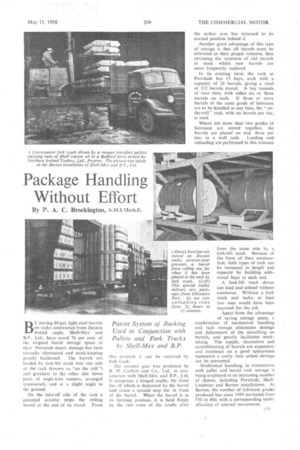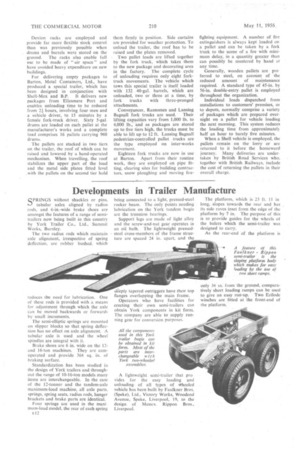Package Handling Without Effort
Page 57

Page 58

If you've noticed an error in this article please click here to report it so we can fix it.
BY storing 40-gal. light steel barrels on racks constructed from Dexion slotted angle, Shell-Mex and B.P., Ltd., have saved 76 per cent. of the original barrel storage, space at their Portsladc depot, damage has been virtually eliminated and stock-keeping greatly facilitated. The barrels arc IrKided by fork-lift truck into one side of tM rack (known as "on the roll ") and gravitate to the other side down pairs of angle-iron runners, arranged transversely and at a slight angle to the ground.
On the take-off side of the rack a patented arrester stops the rolling barrel at the end of its travel. From
this position it can be removed by fork truck.
The arrester gear was produced by R. H. Corbett and Co., Ltd., in conjunction with Shell-Mex and B.P., Ltd. It comprises a hinged cradle, the front bar of which is depressed by the barrel and raises a second stop bar in front of the barrel, When the barrel is in its limiting position, it is held firmly by the two arms of the cradle after the striker arm has returned to its normal position behind it.
Another great advantage of this type of storage is that all barrels must be delivered in their proper rotation, thus obviating the retention of old barrels in stock whilst new barrels are more frequently replaced.
In its existing form the rack at Portslade has 13 bays, each with a capacityof 24 barrels, giving a total of 312 barrels stored. A bay consists of four tiers, with either six or three barrels on each. If three or more barrels of the same grade of lubricant are to be handled at any time, the " onthe-roll " rack, with six barrels per tier, is used.
Where not more than two grades of lubricant are stored together, the barrels are placed on end, three per tier, in a wall rack. Loading and unloading are performed in this instance from the same side by a fork-lift truck. -Because of the form of their construction. both types of rack can be increased in length and capacity by building additional bays at each end.
A fork-lift -truck driver can load and unload without assistance. Without a fork truck and racks, at least two men would have been required for the job.
Apart from the advantage of saving storage space, a combination of mechanical handling and rack storage eliminates damage and defacement of the stencilling on barrels, and greatly facilitates stocktaking. The supply, decoration and reconditioning of barrels are expensive, and insistence on a good appearance represents a costly item unless damage can be prevented.
Mechanical handling, in conjunction with pallet and barrel rack storage is being employed at an increasing number of depots, including Portslade, Shell! Lensbury and Barton installations. At Barton, the number of lubricant grades produced has since 1939 increased from 550 to 800, with a corresponding multiplication of internal movements. Dexion racks are employed and provide far more flexible stock control than was previously possible when drums and barrels were stored on the ground. The racks also enable full use to be made of "air space" and have avoided heavy expenditure on new buildings.
For delivering empty packages to Barton, Metal Containers, Ltd., have produced a special trailer, which has been designed in conjunction with
Shell-Mex and B.P. It delivers new packages from Ellesmere Port and enables unloading time to be reduced from 24 hours, involving four men and a vehicle driver, to 15 minutes by a female fork-truck driver. Sixty 5-gal. drums are loaded on each pallet at the manufacturer's works and a complete load comprises 16 pallets carrying 960 drums.
The pallets are stacked in two tiers on thc trailer, the roof of which can be raised and lowered by a hand-operated mechanism. When travelling, the roof stabilizes the upper part of the load and the metal side plates fitted level . with the pallets on the second tier hold them firmly in position. Side curtains are provided for weather protection. To unload the trailer, the roof has to be raised and the plates removed.
Two pallet loads are lifted together by the fork truck, which takes them to the new package and decorating area in the factory. The complete cycle of unloading requires only eight forktruck movements. The vehicle which tows this special trailer is itself loaded with 132 40-gal. barrels, which are unloaded, two or three at a time, by Fork trucks with three-pronged attachments.
Conveyancer, Ransomes and Lansing Bagnall fork trucks are used. Their lifting capacities vary from 1,000 lb. to 4,000 lb., and as packages are stored up to five tiers high, the trucks must be able to lift up to 12 ft. Lansing Bagnall pedestrian-controlled pallet trucks are the type employed on inter-works movement.
Eighteen fork trucks are now in use at Barton. Apart from their routine work, they are employed on pipe fitting, clearing sites for building contractors, snow ploughing and moving fire
fighting equipment. A number of fire extinguishers is always kept loaded on a pallet and can be taken by a fork truck to the scene of a fire with minimum delay, in a quantity greater than can possibly be mustered by hand at any time.
Generally, wooden pallets are preferred to steel, on account of the reduced amount of maintenance required. A standard type of 45-in. by 56-in, doubIe-entrypallet is employed throughout the organization. Individual loads dispatched from installations to customers' premises, or to depots, normally comprise a variety of packages which are prepared overnight on a pallet for vehicle loading the next morning. This system reduces the loading time from approximately half an hour to barely five minutes.
When a Shell vehicle is employed, the pallets remain on the lorry or are returned to it before the homeward journey. Many deliveries are under, taken by British Road Services who, together with British Railways, include the cost of returning the pallets in their overall charge.




























































































































